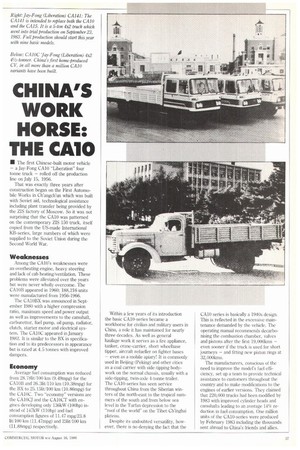CHINA'S WORK HORSE: THE CA10
Page 39

If you've noticed an error in this article please click here to report it so we can fix it.
• The first Chinese-built motor vehicle — a Jay-Fong CA10 "Liberation" four tonne truck — rolled off the production line on July 15, 1956.
That was exactly three years after construction began on the First Automobile Works in Ch'angch'un which was built with Soviet aid, technological assistance including plant transfer being provided by the Z1S factory of Moscow. So it was not surprising that the CA10 was patterned on the contemporary Z1S 150 truck, itself copied from the US-made International KB-series, large numbers of which were supplied to the Soviet Union during the Second World War.
Weaknesses
Among the CA10's weaknesses were an overheating engine, heavy steering and lack of cab heating/ventilation. These problems were alleviated over the years but were never wholly overcome. The C A 10B appeared in 1960; 188,216 units were manufactured from 1956-1966.
The CA1OBX was announced in September 1980 with a higher compression ratio, maximum speed and power output as well as improvements to the camshaft, carburettor, fuel pump, oil pump, radiator, clutch, starter motor and electrical system. The CA10C appeared in January 1982. It is similar to the BX in specification and to its predecessors in appearance but is rated at 4.5 tonnes with improved dampers.
Economy
Average fuel consumption was reduced from 28.78Iiti100 km (9.49mpg) for the CA10B and 26.3lit/110 km (10.38mpg) for the BX to 25.151iti100 km (10.86mpg) for the CA10C. Two "economy" versions are the CAlOCJ and the CAlOCT with engines developing only 136kW (100hp) instead of 147kW (110hp) and fuel consumption figures of 11.47 mpg/23.8 lit/100 km (11.47mpg) and 231it/100 km (11.88mpg) respectively. Within a few years of its introduction the basic CA10-series became a workhorse for civilian and military users in China, a role it has maintained for nearly three decades. As well as general haulage work it serves as a fire appliance, tanker, crane-carrier, short wheelbase tipper, aircraft refueller on fighter bases — even as a mobile apiary! It is commonly used in Beijing (Peking) and other cities as a coal carrier with side-tipping bodywork on the normal chassis, usually with a side-tipping, twin-axle 4-tonne trailer. The CA10-series has seen service throughout China from the Siberian winters of the north-east to the tropical summers of the south and from below sea level in the Turfan depression to the "roof of the world" on the Tibet-Ch'inghai plateau.
Despite its undoubted versatility, however, there is no denying the fact that the CA10 series is basically a 1910s design. This is reflected in the excessive maintenance demanded by the vehicle. The operating manual recommends decarbonising the combustion chamber, valves and pistons after the first 19, 000kms — even sooner if the truck is used for short journeys — and fitting new piston rings at 32,000kms.
The manufacturers, conscious of the need to improve the model's fuel efficiency, set up a team to provide technical assistance to customers throughout the country and to make modifications to the engines of earlier versions. They claimed that 220,000 trucks had been modified by 1983 with improved cylinder heads and camshafts leading to an average 14% reduction in fuel consumption. One million units of the CA10-series were produced by February 1983 including the thousands sent abroad to China's friends and allies.




































































